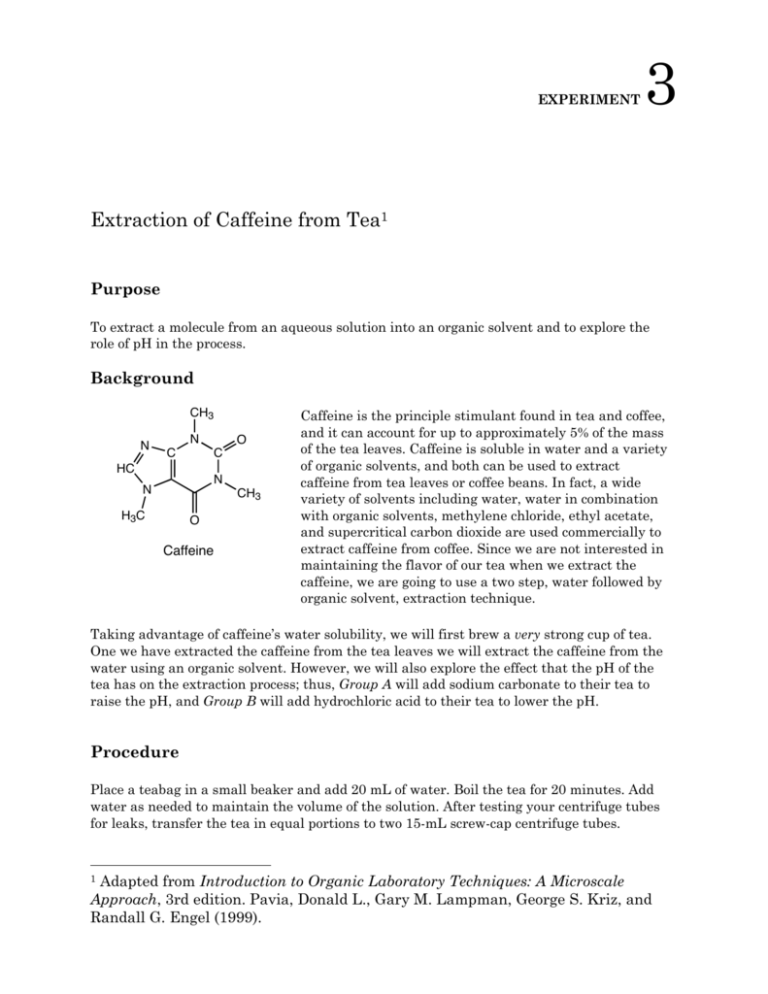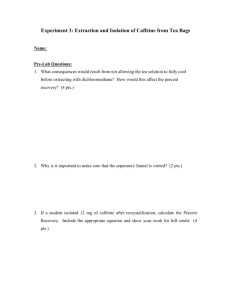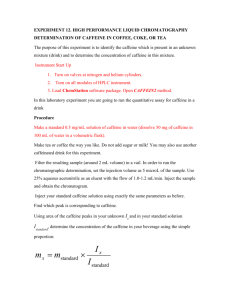Extraction Of Caffeine From Tea
advertisement

EXPERIMENT 3 Extraction of Caffeine from Tea1 Purpose To extract a molecule from an aqueous solution into an organic solvent and to explore the role of pH in the process. Background CH3 N N C O C HC N N CH3 H3C O Caffeine Caffeine is the principle stimulant found in tea and coffee, and it can account for up to approximately 5% of the mass of the tea leaves. Caffeine is soluble in water and a variety of organic solvents, and both can be used to extract caffeine from tea leaves or coffee beans. In fact, a wide variety of solvents including water, water in combination with organic solvents, methylene chloride, ethyl acetate, and supercritical carbon dioxide are used commercially to extract caffeine from coffee. Since we are not interested in maintaining the flavor of our tea when we extract the caffeine, we are going to use a two step, water followed by organic solvent, extraction technique. Taking advantage of caffeine’s water solubility, we will first brew a very strong cup of tea. One we have extracted the caffeine from the tea leaves we will extract the caffeine from the water using an organic solvent. However, we will also explore the effect that the pH of the tea has on the extraction process; thus, Group A will add sodium carbonate to their tea to raise the pH, and Group B will add hydrochloric acid to their tea to lower the pH. Procedure Place a teabag in a small beaker and add 20 mL of water. Boil the tea for 20 minutes. Add water as needed to maintain the volume of the solution. After testing your centrifuge tubes for leaks, transfer the tea in equal portions to two 15-mL screw-cap centrifuge tubes. Adapted from Introduction to Organic Laboratory Techniques: A Microscale Approach, 3rd edition. Pavia, Donald L., Gary M. Lampman, George S. Kriz, and Randall G. Engel (1999). 1 Members of Group A, add 0.5 g of sodium carbonate to each centrifuge tube. Members of Group B, add 1 mL of 6 M hydrochloric acid to each centrifuge tube. Cap the centrifuge tubes and carefully shake them. Remember to vent your centrifuge tubes. Once the sodium carbonate has dissolved and the tea has cooled to room temperature, add 3 mL of methylene chloride (also called dichloromethane) to each test tube. Cap the test tubes and shake the tubes. Remember to vent your centrifuge tubes. Spin your tea–methylene chloride suspensions in a centrifuge for five minutes to break the emulsion. Remember to balance your centrifuge tubes in the centrifuge. Carefully transfer the organic layer from each centrifuge tube to a third 15-mL centrifuge tube. Repeat the methylene chloride extraction and transfer with additional 3 mL aliquots of methylene chloride, one for each centrifuge tube. With a clean dry Pasteur pipet, transfer your methylene chloride solution to a fourth 15-mL centrifuge tube. It is very important that no water is transferred during this step. Dry the organic solvent with anhydrous sodium sulfate. To remove the solvent, transfer a 3 mL aliquot of your dry methylene chloride–caffeine solution to a tared 5-mL conical vial. Warm the vial and the solution therein in a hot water bath (50 °C max) and gently blow compressed air onto the solution. As the methylene chloride evaporates, transfer more of your methylene chloride–caffeine solution to the vial. Continue gently heating the solution until all of the solvent has evaporated. Determine the mass of your crude caffeine, and recrystallize your caffeine using acetone and hexanes. Dissolve your caffeine in a minimum of warm acetone (start with approximately 0.5 mL acetone) and transfer the solution to a Craig tube. Slowly layer hexanes on top of the solution. Allow crystals to form and then cool the suspension in an ice-water bath. Spin your Craig tube in a centrifuge to isolate the caffeine. Report Working with one partner, collect data for the yield of crude caffeine, making certain to note whether the individual added hydrochloric acid or sodium carbonate, from each student in your laboratory class, and tabulate the data. Report the average mass of caffeine isolated for each technique and the percent error associated with the reported average mass. Respond to the following: the average mass of the tea in a tea bag is 2.3610 g and the percent error associated with that measurement is 0.93 %. Is the difference in the average mass of the caffeine collected by Group A and Group B significant? If it is significant, which group collected more caffeine? Consider the structure of caffeine and provide an explanation for the difference in the in the average mass of caffeine collected. When explaining the difference consider, how HCl might interact with caffeine. Consider how charged molecules (ions) interact with water as compared to neutral molecules; in other words, which would be more soluble in water, a neutral caffeine molecule or a charged caffeine molecule. Which would be more soluble in an organic solvent, a charged molecule or a neutral molecule?








